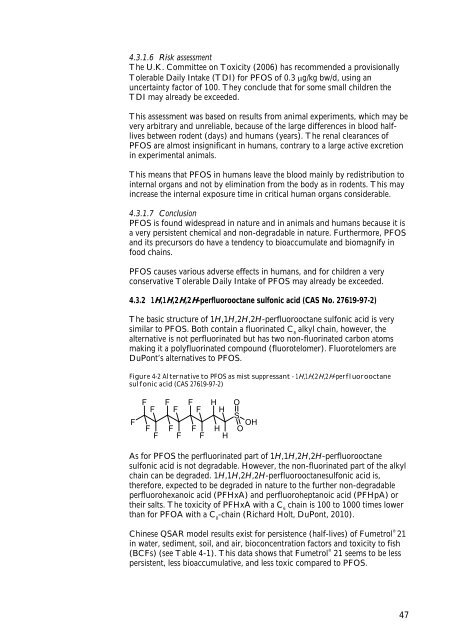Substitution of PFOS for use in nondecorative hard chrome plating
Substitution of PFOS for use in nondecorative hard chrome plating
Substitution of PFOS for use in nondecorative hard chrome plating
Create successful ePaper yourself
Turn your PDF publications into a flip-book with our unique Google optimized e-Paper software.
4.3.1.6 Risk assessment<br />
The U.K. Committee on Toxicity (2006) has recommended a provisionally<br />
Tolerable Daily Intake (TDI) <strong>for</strong> <strong>PFOS</strong> <strong>of</strong> 0.3 g/kg bw/d, us<strong>in</strong>g an<br />
uncerta<strong>in</strong>ty factor <strong>of</strong> 100. They conclude that <strong>for</strong> some small children the<br />
TDI may already be exceeded.<br />
This assessment was based on results from animal experiments, which may be<br />
very arbitrary and unreliable, beca<strong>use</strong> <strong>of</strong> the large differences <strong>in</strong> blood halflives<br />
between rodent (days) and humans (years). The renal clearances <strong>of</strong><br />
<strong>PFOS</strong> are almost <strong>in</strong>significant <strong>in</strong> humans, contrary to a large active excretion<br />
<strong>in</strong> experimental animals.<br />
This means that <strong>PFOS</strong> <strong>in</strong> humans leave the blood ma<strong>in</strong>ly by redistribution to<br />
<strong>in</strong>ternal organs and not by elim<strong>in</strong>ation from the body as <strong>in</strong> rodents. This may<br />
<strong>in</strong>crease the <strong>in</strong>ternal exposure time <strong>in</strong> critical human organs considerable.<br />
4.3.1.7 Conclusion<br />
<strong>PFOS</strong> is found widespread <strong>in</strong> nature and <strong>in</strong> animals and humans beca<strong>use</strong> it is<br />
a very persistent chemical and non-degradable <strong>in</strong> nature. Furthermore, <strong>PFOS</strong><br />
and its precursors do have a tendency to bioaccumulate and biomagnify <strong>in</strong><br />
food cha<strong>in</strong>s.<br />
<strong>PFOS</strong> ca<strong>use</strong>s various adverse effects <strong>in</strong> humans, and <strong>for</strong> children a very<br />
conservative Tolerable Daily Intake <strong>of</strong> <strong>PFOS</strong> may already be exceeded.<br />
4.3.2 1H,1H,2H,2H-perfluorooctane sulfonic acid (CAS No. 27619-97-2)<br />
The basic structure <strong>of</strong> 1H,1H,2H,2H-perfluorooctane sulfonic acid is very<br />
similar to <strong>PFOS</strong>. Both conta<strong>in</strong> a fluor<strong>in</strong>ated C 8 alkyl cha<strong>in</strong>, however, the<br />
alternative is not perfluor<strong>in</strong>ated but has two non-fluor<strong>in</strong>ated carbon atoms<br />
mak<strong>in</strong>g it a polyfluor<strong>in</strong>ated compound (fluorotelomer). Fluorotelomers are<br />
DuPont’s alternatives to <strong>PFOS</strong>.<br />
Figure 4-2 Alternative to <strong>PFOS</strong> as mist suppressant - 1H,1H,2H,2H-perfluorooctane<br />
sulfonic acid (CAS 27619-97-2)<br />
F<br />
F<br />
F<br />
F F<br />
F<br />
F<br />
F F<br />
F<br />
F H<br />
H<br />
F F<br />
H<br />
H<br />
O<br />
S<br />
OH<br />
O<br />
As <strong>for</strong> <strong>PFOS</strong> the perfluor<strong>in</strong>ated part <strong>of</strong> 1H,1H,2H,2H-perfluorooctane<br />
sulfonic acid is not degradable. However, the non-fluor<strong>in</strong>ated part <strong>of</strong> the alkyl<br />
cha<strong>in</strong> can be degraded. 1H,1H,2H,2H-perfluorooctanesulfonic acid is,<br />
there<strong>for</strong>e, expected to be degraded <strong>in</strong> nature to the further non-degradable<br />
perfluorohexanoic acid (PFHxA) and perfluoroheptanoic acid (PFHpA) or<br />
their salts. The toxicity <strong>of</strong> PFHxA with a C 6 cha<strong>in</strong> is 100 to 1000 times lower<br />
than <strong>for</strong> PFOA with a C 8 -cha<strong>in</strong> (Ric<strong>hard</strong> Holt, DuPont, 2010).<br />
Ch<strong>in</strong>ese QSAR model results exist <strong>for</strong> persistence (half-lives) <strong>of</strong> Fumetrol ® 21<br />
<strong>in</strong> water, sediment, soil, and air, bioconcentration factors and toxicity to fish<br />
(BCFs) (see Table 4-1). This data shows that Fumetrol ®<br />
21 seems to be less<br />
persistent, less bioaccumulative, and less toxic compared to <strong>PFOS</strong>.<br />
47

















